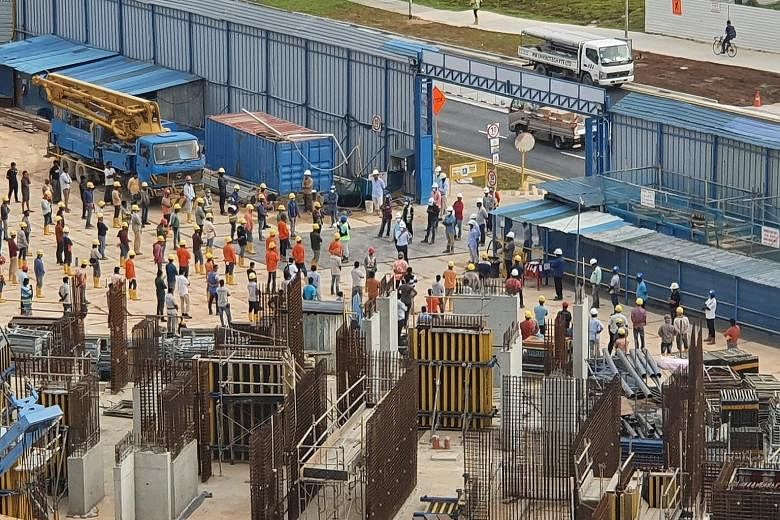An industry task force is examining how Covid-19 infections can be prevented in the construction sector when work gradually resumes after the circuit breaker ends, The Straits Times has learnt.
Comprising eight to 10 members of the Singapore Contractors Association Limited (Scal), it is working with the authorities to devise new practices, said Scal first vice-president Lee Kay Chai.
Details are still in the works, but the guidelines being looked at will cover safe worksites, accommodation and transport, said Mr Lee.
A circular highlighting the need for new measures was sent to Scal members last Friday. These will expand on existing guidelines introduced before the circuit breaker. Most construction work was halted when the circuit breaker started.
By the end of this month, it is expected that 20,000 migrant workers who are infected with Covid-19 will have recovered. All 323,000 workers in dormitories will be tested to ensure they are free of the virus before they return to work.
Migrant workers make up the bulk of Covid-19 cases here, with transmission at dormitories and worksites and in social settings believed to be the key reason for the rapid spread among the community over the past few months.
Scal, which represents about 3,000 companies, is exploring how employees in the same project can be housed in the same dormitory or on-site housing to reduce mixing with other workers, said Mr Lee.
A typical worksite could include workers from up to 10 different dorms or housing sites, depending on its type, said industry players. Several sub-contractors from different firms would also be present along with the main contractor.
But while it would be ideal if all workers at the same site could be housed together, there are practical difficulties, Mr Lee acknowledged. For instance, many projects may not have enough space for temporary dorms to house all workers.
The task force, which was set up three weeks ago, is also looking at work processes. "We have specialist contractors who work on multiple projects at a time. If you want to isolate (their workers) at one project site, then there will be a shortage of manpower for them, and also a lot of redundancy, as they may not have enough work to do on some days," Mr Lee said.
Employers and workplace safety and health experts agreed with the need for stricter measures.
Mr Johnny Lim, executive director of Teambuild Engineering and Construction, said contractors will have to plan ahead to reduce the need for sub-contractor workers who handle specific tasks like tiling to move from site to site.
Workplace safety and health trainer Han Wenqi said workers performing the same function will need to be grouped together and mix only within the same group, including at meal or break times.
But Dr Goh Yang Miang, former chairman of the health and safety engineering technical committee at The Institution of Engineers, Singapore, noted that the effectiveness of measures like safe distancing and the use of protective equipment such as masks are heavily reliant on whether workers comply.
While these measures are vital, using technology at worksites will play a more important role in the near future in curbing the further spread of Covid-19, he said.
"The industry has traditionally been very reliant on manual work, and more expensive options such as using more machinery were deemed as impractical due to cost... many contractors will need to re-evaluate their position on this."
What industry players suggest
• Reduce the number of workers on lorries and buses when they are driven from dormitories to worksites. This can be done by increasing vehicular capacity or by staggering work hours so that multiple trips can be made by one lorry or bus.
• Wear face masks at worksites at all times.
• House all workers, who may have stayed at different sites, at the same project site where possible. Some building sites, which may have completed works on multi-storey carparks, for instance, can be temporarily converted into housing for workers.
• Minimise the movement or cross-deployment of workers and sub-contractors across different project sites where possible. Work processes can be re-organised to support this. If there is a need for such cross-deployment, workers must be split into teams and their details taken to facilitate contact tracing if a Covid-19 case emerges.
• Split up workers into smaller groups at worksites and ensure that they mix only within these groups. The use of physical barriers or wearing of colour-coded bands can help ensure such segregation.
• Stagger work hours to reduce the number of workers at a site. This could involve allowing some work to continue at night.
• Appoint an independent third-party inspector to enforce safe distancing and management practices.
• Disinfect tools, machines and vehicles on a daily basis.












